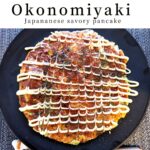What is Okonomiyaki?
Okonomiyaki is a popular Japanese savory pancake that is often referred to as “Japanese pancake.” The name “okonomiyaki” comes from the words “okonomi,” meaning “what you like” or “what you want,” and “yaki,” meaning “grilled” or “cooked.” This reflects the customizable nature of the dish, as you can add various ingredients to suit your taste.
Ingredients and Preparation:
The basic ingredients for okonomiyaki include:
- Batter: Made from flour, water, and shredded cabbage.
- Fillings: You can add anything you like, such as vegan cheese, mochi, or kimchi.
- Toppings: Typically topped with okonomiyaki sauce (a sweet and savory sauce), Japanese mayonnaise, bonito flakes (dried fish flakes), aonori (seaweed flakes), and pickled ginger.
Regional Variations:
There are different styles of okonomiyaki depending on the region in Japan:
- Osaka Style: The most common style, where all ingredients are mixed together before cooking.
- Hiroshima Style: Ingredients are layered rather than mixed, and noodles (yakisoba or udon) are often added.
Cultural Significance:
Okonomiyaki is not just a delicious dish but also a social experience. It’s often cooked at the table on a hot griddle, making it a fun and interactive meal to enjoy with friends and family. It’s a staple at festivals and street food markets in Japan, and many restaurants specialize in okonomiyaki, allowing customers to cook their own at the table.
History of Okonomiyaki: The roots of okonomiyaki date back to the Azuchi-Momoyama period (about 400 years ago) with a dish called “funoyaki,” which was made by dissolving wheat flour in water and baking it. This is considered the prototype of modern okonomiyaki. It was eaten as a snack at that time.
Later, in the Meiji period (about 150 years ago), a similar dish called “monjayaki” became popular in Tokyo. However, monjayaki was too runny for takeout or mobile sales, so in the Taisho period (about 110 years ago), a firmer version called “dondon-yaki” was sold at local festivals. After World War II, during the food crisis, the current style of okonomiyaki, which includes a lot of cabbage and flour provided in large quantities by the U.S., became popular. The name “okonomiyaki” started being used as people began adding their favorite ingredients.
Nutritional Benefits of Cabbage:
- Digestive Health: Cabbage contains vitamin U (cabbagin), which protects the stomach lining and helps alleviate stomach pain and indigestion.
- Immune Boost: Rich in vitamin C, cabbage enhances immune function, helping to prevent colds and alleviate symptoms.
- Relieves Constipation: High in insoluble fiber, cabbage promotes the growth of beneficial gut bacteria and stimulates bowel movements.
- Prevents High Blood Pressure: Cabbage is rich in potassium, which helps excrete sodium and prevent high blood pressure.
Okonomiyaki
Equipment
- Measuring scale
- blender
- grater
- bowl
- knife
- cutting board
- heat-resistant container
- tablespoon
- teaspoon
- frying pan
- spatula
Ingredients
Ingredients for Okonomiyaki:
- 60 g all-purpose flour
- 1/2 tsp salt
- 100 g firm tofu You can use 200g of silken tofu as a substitute.
- 200 g cabbage
- 2 potatoes
- Otafuku okonomiyaki sauce as much as you like
If you can’t find okonomiyaki sauce, you can make it by yourself
- 1/4 cup ketchup
- 2 tbs Worcestershire sauce
- 1 tbs soy sauce
- 2 tbs maple syrup
Ingredients for Tofu Mayonnaise:
- 150 g 6oz silken tofu
- 1/4 tsp salt
- 1/4 tsp mustard
- 1/4 tsp balsamic vinegar or lemon juice or other vinegar
- 1 or more tbsp vegetable oil optional, you can omit if you prefer no oil
Toppings:
- green onions optional
- paprika powder optional
- aonori(green seaweed flake) optional
- pickled ginger optional
Instructions
Make the Mayonnaise:
- Put 130g (6oz) silken tofu, 1/2 tsp mustard, 1/4 tsp salt, 1/4 tsp balsamic vinegar, and 1 tbsp vegetable oil into a blender and blend for 1 minute.
- Taste and adjust the amount of oil and salt as you like. You can omit the oil if you prefer no oil.
Make the Okonomiyaki Batter:
- Shred the cabbage and put it in a bowl. Add tofu and 1/2 tsp salt, and mix well.
- Grate the potatoes and add them to the bowl with the cabbage, mixing well.
- Finally, add the flour and mix lightly until just combined. Do not overmix after adding the flour.
Cook the Okonomiyaki:
- Lightly oil a large frying pan and heat over medium heat. Once hot, add half of the okonomiyaki batter and spread it thinly.
- Cover and cook for about 5 minutes, checking occasionally to prevent burning. Flip and cook for another 5 minutes.
- Repeat with the second okonomiyaki.
Serve:
- Spread about 2 tbsp or as much as you like of sauce on top of each okonomiyaki, and drizzle with tofu mayonnaise in thin lines. Use a toothpick or chopstick to create a pattern by connecting the mayonnaise and sauce.
- Add toppings like green onions, pickled ginger, dill, paprika powder, as you like.
Storage
- Store in an airtight container in the refrigerator for 2-3 days. If freezing, wrap in plastic wrap and place in a ziplock bag for up to one month.





コメント